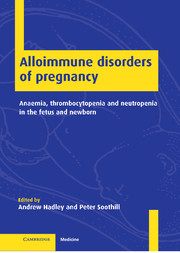 Alloimmune Disorders of Pregnancy
Alloimmune Disorders of Pregnancy Book contents
- Frontmatter
- Contents
- List of contributors
- Preface
- Foreword
- List of abbreviations
- 1 Pathophysiology of the alloimmune cytopenias
- 2 Blood group antibodies in haemolytic disease of the fetus and newborn
- 3 Basis and practice of screening for haemolytic disease of the fetus and newborn
- 4 Epidemiology and screening for alloimmune thrombocytopenia
- 5 Principles of antibody-mediated immune suppression and the prevention of maternal RhD alloimmunization
- 6 The clinical application of anti-D prophylaxis
- 7 Fetal genotyping
- 8 Laboratory assays to determine the severity of haemolytic disease of the fetus and newborn
- 9 Assessing the severity of haemolytic disease of the fetus and newborn: clinical aspects
- 10 Antenatal therapy for haemolytic disease of the fetus and newborn
- 11 Neonatal therapy for haemolytic disease of the newborn
- 12 The diagnosis of alloimmune thrombocytopenia
- 13 The immunological diagnosis of alloimmune neutropenia
- 14 Fetal and neonatal treatment of alloimmune thrombocytopenia
- Index
11 - Neonatal therapy for haemolytic disease of the newborn
Published online by Cambridge University Press: 26 October 2009
- Frontmatter
- Contents
- List of contributors
- Preface
- Foreword
- List of abbreviations
- 1 Pathophysiology of the alloimmune cytopenias
- 2 Blood group antibodies in haemolytic disease of the fetus and newborn
- 3 Basis and practice of screening for haemolytic disease of the fetus and newborn
- 4 Epidemiology and screening for alloimmune thrombocytopenia
- 5 Principles of antibody-mediated immune suppression and the prevention of maternal RhD alloimmunization
- 6 The clinical application of anti-D prophylaxis
- 7 Fetal genotyping
- 8 Laboratory assays to determine the severity of haemolytic disease of the fetus and newborn
- 9 Assessing the severity of haemolytic disease of the fetus and newborn: clinical aspects
- 10 Antenatal therapy for haemolytic disease of the fetus and newborn
- 11 Neonatal therapy for haemolytic disease of the newborn
- 12 The diagnosis of alloimmune thrombocytopenia
- 13 The immunological diagnosis of alloimmune neutropenia
- 14 Fetal and neonatal treatment of alloimmune thrombocytopenia
- Index
Summary
Improvements in preventative and therapeutic fetal medicine, such as the better timing of delivery guided by Liley's charts, fetal blood transfusion and the wide-spread use of anti-D immunoglobulin, have had dramatic effects on morbidity and mortality due to HDFN. Advances in neonatal intensive care have further contributed to this reduction. This chapter reviews therapies which may be used to treat hydrops, anaemia and jaundice in affected neonates.
Features of haemolytic disease in the neonate
There are three main clinically significant conditions seen during the first 28 days after birth caused by maternal blood group alloantibodies transferred to the fetus. These are hydrops, jaundice and anaemia.
Hydrops
The most severely affected fetuses present with hydrops manifesting as generalized tissue oedema, pleural effusions and ascites. Although the pathogenesis of these features is not clear, presumably neonates born with hydrops suffer the end result of fetal heart failure due to both hypoxic myocardial dysfunction and increased intravascular fluid retention (Section 9.3.1). Fetal liver dysfunction may also contribute to the oedema because the extensive erythropoiesis causes disruption to the portal circulation and impaired albumin synthesis. Antenatal treatment is aimed at the correction of the anaemia by fetal blood transfusion (Section 10.3), but, when a neonate is born with hydrops, early neonatal death may result from the inability to resuscitate the severely hydropic and anaemic baby at delivery. Later postnatal death may result from other consequences of hydrops, such as pulmonary hypoplasia, the complications of prematurity or even complications of treatment such as exchange transfusion.
- Type
- Chapter
- Information
- Alloimmune Disorders of PregnancyAnaemia, Thrombocytopenia and Neutropenia in the Fetus and Newborn, pp. 203 - 218Publisher: Cambridge University PressPrint publication year: 2001


